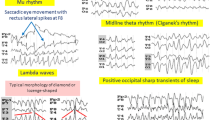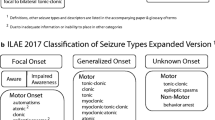Summary
The EEG of convulsions induced by Metrazol under general anaesthesia and muscular relaxation was studied in 86 patients with endogenous psychoses. 621 seizures were analysed. The authors distinguished the following 8 successive stages of the seizure: 1. Desynchronization, 2. bursts of “polyspikes and wave” complexes, 3. second phase of desynchronization, 4. rhythmical, sinusoidal high voltage activity of a frequency of approximately 10c/s, 5. spike and wave complexes, 6. phase of isoelectricity, 7. episodic delta activity, 8. diffuse delta activity.
The initial clonic stage of the seizure corresponds to EEG phase 2, the tonic stage to phases 3 and 4, the clonic stage to phase 5, the postictal period to phase 6 to 8.
The authors analysed the neurophysiological mechanisms of the different stages studied; they consider that the convulsion induced by Metrazol is a suitable model of the major epileptic seizure. In their opinion, phase 2 is due to a partial activation of non-specific thalamic nuclei. Phase 4 is considered to be a recruiting reaction. The elonic and the isoelectric stages are produced by an activation of an antiepileptic caudato-thalamic inhibitory system, which first rhythmically interrupts, and later fully supresses, the epileptic activity.
Zusammenfassung
Das EEG des Pentamethylentetrazolkrampfes (PK) in Narkose und Relaxation wurde bei 86 Patienten mit endogenen Psychosen untersucht. Insgesamt wurden 621 Anfälle analysiert. Das EEG des Anfalls haben die Verfasser in 8 aufeinanderfolgende Stadien eingeteilt: 1. Desynchronisierung, 2. Ausbrüche von Komplexen in Form von „polyspikes-waves“, 3. erneute Desynchronisierung, 4. spannungshohe, rhythmische, sinusoidale Aktivität von ungefähr 10/s, 5. sw-Komplexe, 6. isoelektrisches Stadium, 7. episodische Deltaaktivität, 8. diffuse Deltaaktivität. Vom klinischen Standpunkt entspricht dem 2. Stadium das sog. klonische Vorstadium, dem 3. und 4. Stadium die tonische und dem 5. Stadium die klonische Krampfphase, dem 6.–8. Stadium die postparoxysmale Periode.
Die Verfasser interpretieren die neurophysiologischen Entstehungsmechanismen der einzelnen beschriebenen Stadien, wobei sie den PK für ein geeignetes Modell des epileptischen grand mal-Anfalles halten. Das 2. Stadium wird als partielle Aktivierung unspezifischer Thalamuskerne gedeutet, das 4. Stadium als sog. “recruiting reaction”. Die Entstehung des klonischen sowie des isoelektrischen Stadiums wird durch Einwirkung eines caudatothalmischen Inhibitionssystems erklärt, welches die epileptische Entladung zuerst rhythmisch unterbricht und später völlig unterdrückt.
Similar content being viewed by others
Literatur
Binswanger, O.: Die Epilepsie. In (H. Nothnagel, Hrsg.): Specielle Pathologie und Therapie. Bd. 12, 1. Hälfte, 1. Abt., S. 1–503. Wien: Hölder 1904.
Bremer, F.: Strychnine tetanus and mechanism of neuronal synchronization. Proc. Soc. exper. Biol. (N. Y.) 46, 627–628 (1941).
Chatrian, G. E., and M. C. Petersen: The convulsive patterns provoked by indoklon, metrazol and electroshock: some depth electrographic observations in human patients. Electroenceph. clin. Neurophysiol. 12, 715–725 (1960).
Cremerius, J., u. R. Jung: Über die Veränderungen des Elektrencephalogramms nach Elektroschockbehandlung. Nervenarzt 18, 193–205 (1947).
Davis, P. A., and W. Sulzbach: Changes in the electroencephalogram during metrazol therapy. Arch. Neurol. Psychiat. (Chic.) 43, 341–355 (1940).
Dempsey, E. W., and R. S. Morison: The production of rhythmically recurrent cortical potentials after localized thalamic stimulation. Amer. J. Physiol. 135, 293–300 (1942).
— —: The electrical activity of a thalamocortical relay system. Amer. J. Physiol. 138, 283–296 (1943).
Economo, K. v., u. J. P. Karplus: zit. nach Gastaut u. Fischer—Williams (1963).
Gastaut, H.: Epilepsies. In: Encyclopédie médico-chirurgicale 1963, fasc. 17045 A 10, p. 1–44.
-, and M. Fischer-Williams: Electroencephalographic study of syncope; its differentiation from epilepsy. Lancet 1957, 1018–1025.
— —: The physiopathology of epileptic seizures. In: J. Field, H. W. Magoun, and V. E. Hall (edit.): Handbook of Physiology, sect. I. (Neurophysiology), vol. I., p. 329–363. Amer. Physiol. Assoc., Washington 1963.
—, and J. Hunter: An experimental study of the mechanism of photic activation in idiopathic epilepsy. Electroenceph. clin. Neurophysiol. 2, 263–287 (1950).
Guttierez-Noriega: In: Cardiazol. Ludwigshafen am Rhein: Knoll A.G. 1951.
Jung, R.: Hirnelektrische Untersuchungen über den Elektrokrampf: die Erregungsabläufe in corticalen und subcorticalen Hirnregionen bei Katze und Hund. Arch. Psychiat. Nervenkr. 183, 206–244 (1949).
Lugaresi, E., G. Cipriani, G. Orioli, D. Gambi e V. Volterra: La crisi gran male di cardiazol e da elettroshock in sogetti curarizzati. Riv. Neurol. 36, 178–190 (1966).
Mettler, F. A., and C. C. Mettler: Conversion of phasic into tonic movements by pyramid lesions. J. Neurophysiol. 3, 527–537 (1940).
Meyer-Mickeleit, R. W.: Das Elektrencephalogramm beim Elektrokrampf des Menschen. Arch. Psychiat. Nervenkr. 183, 12–33 (1949).
Mezan, J., K. Milenkov, S. Saev, and K. Tenev: Electrographic study on therapeutic cardiazolic convulsions under muscle relaxation. C. R. Acad. Bulg. Sci. 16, 429–432 (1963).
Morison, R. S., and E. W. Dempsey: A study of thalamocortical relations. Amer. J. Physiol. 135, 281–292 (1942).
— —: Mechanism of thalamocortical augmentation and repetition. Amer. J. Physiol. 138, 297–308 (1943).
Moruzzi, G.: L'épilepsie expérimentale. Paris: Hermann 1950.
Müller, H. W.: Über die elektroencephalographischen Veränderungen beim experimentellen Krampfanfall durch Cardiazol-Teilinjektionen. Z. ges. exp. Med. 116, 318–326 (1950).
Muskens, J. J.: L'épilepsie. Antwerpen: De Vos-Van Klef 1926.
Nevšímal, O., u. B. Roth: Tetanie und Zentralnervensystem. Berlin: VEB Volk und Gesundheit 1963.
Prus, J.: Wien. klin. Wschr. 11, 857 (1898), zit. nach Gastaut u. Fischer-Williams (1963).
Russel, J.: Cases of suspended cerebral function occuring among the phenomena following epileptic fits. Med. Times Gaz. (1882); zit. nach Gastaut u. Fischer-Williams (1963).
Servit, Z.: Základy evoluční pathologie epilepsie. (Die Grundlagen der Evolutionspathologie der Epilepsie.) Prag: Nakladatelství ČSAV 1958.
Spiegel, E. A., u. Y. Nishikawa: Der zentrale Mechanismus der Tetaniekrämpfe und ihre Beziehungen zur Enthirnungsstarre. Arbeiten aus dem Neurol. Inst. Wien 24, 221–252 (1923).
Starzl, T. E., and H. W. Magoun: Organization of diffuse thalamic projection system. J. Neurophysiol. 14, 133–146 (1951).
—, W. T. Niemer, M. B. Dell, and P. R. Forgrave: Cortical and subcortical electrical activity in experimental seizures induced by metrazol. J. Neuropath. exp. Neurol. 12, 262–276 (1953).
Strauss, H., C. Landis, and W. A. Hunt: The metrazol seizure and its significance for the pathophysiology of the epileptic attack. J. nerv. ment. Dis. 90, 439–452 (1939).
Ward, A. A.: Decerebrate rigidity. J. Neurophysiol. 10, 89–103 (1947).
Wortis, S. B., and D. Klenke: Experimental convulsions following lesions of the tuber cinereum. Amer. J. Psychiat. 12, 1039–1047 (1933).
Zanchetti, A., and J. M. Brookhart: Measurement of electrical responsivness of corticospinal efferents in cat and monkey. J. Neurophysiol. 18, 288–298 (1955).
Author information
Authors and Affiliations
Rights and permissions
About this article
Cite this article
Roth, B., Stein, J., Schulz, H. et al. Die bioelektrisch kontrollierte Krampfbehandlung der endogenen Psychosen in Narkose und Relaxation. Arch. F. Psychiatr. U. Z. Neur. 211, 433–447 (1968). https://doi.org/10.1007/BF00404475
Received:
Issue Date:
DOI: https://doi.org/10.1007/BF00404475




